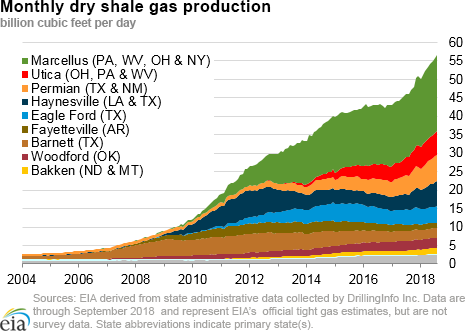In the News:
Two new large pipelines placed into service in October are increasing Northeast takeaway capacity
Several new key pipelines and compressor stations entered service in October, increasing takeaway capacity from the Marcellus and Utica Basins in the northeastern United States. Total new capacity this month is 1.85 billion cubic feet per day (Bcf/d), a significant share of the 3.2 Bcf/d of new takeaway capacity in Pennsylvania and Ohio that has come online (or is scheduled to come online) during the fourth quarter of 2018.
Newly-constructed greenfield pipelines include:
Phase II of Transcontinental Gas Pipeline’s (Transco) Atlantic Sunrise Pipeline Project
Atlantic Sunrise Phase II was placed into full service on October 6 and adds 0.85 Bcf/d of capacity. Phase IA and IB of the project were completed in July 2017 and June 2018, respectively. This pipeline project, with a total capacity of 1.7 Bcf/d, connects Marcellus natural gas supplies to the Transco system and increases its bidirectional capacity from the mid-Atlantic into Southern markets, extending into Alabama and connecting to export markets. Within a few days of entering service, the Central Penn southbound line of the Atlantic Sunrise—with flows to the Pennsylvania and Maryland border—reached capacity (1.7 Bcf/d), according to data from S&P Global.
Enbridge’s NEXUS Pipeline
The 255 mile-long NEXUS pipeline was placed into partial service October 10–12, adding 1.0 Bcf/d of an approved maximum capacity of 1.5 billion Bcf/d. This greenfield pipeline will transport natural gas to the upper U.S. Midwest and eastern Canadian markets. Enbridge’s Texas Eastern Appalachian Lease pipeline delivers natural gas to the NEXUS pipeline from the Marcellus and Utica Basins and entered service a little more than a week before the NEXUS pipeline, on September 29. In recent days, flows are estimated to be close to 1.0 Bcf/d.
In addition to these projects, the Columbia Pipeline Group has several pipeline expansions slated to come online or into partial service in the near term. The compressor station for the Mountaineer XPress (2.7 Bcf/d) began operations on October 9. The first westbound phase of the WB XPress (1.3 Bcf/d) gained approval to enter service on October 4 and is expected to be in service by November.
In its latest Short-Term Energy Outlook (STEO), EIA estimates total dry gas production in September was 85.1 Bcf/d, and it is forecast to reach 86.2 Bcf/d by the end of 2018. As new pipeline projects in the Northeast region come online, production is expected to increase. Outlets into growing markets can help to alleviate capacity constraints that have previously restricted production growth. With proposed 2018 projects, the estimated takeaway capacity by the end of the year will top 23 Bcf/d, up 5 Bcf/d from last year.
Overview:
(For the Week Ending Wednesday, October 17, 2018)
- Although natural gas spot prices rose at most locations this report week (Wednesday, October 10 to Wednesday, October 17), Henry Hub spot prices fell from $3.37 per million British thermal units (MMBtu) last Wednesday to $3.31/MMBtu yesterday.
- At the New York Mercantile Exchange (Nymex), the November 2018 contract price rose 4¢ from $3.284/MMBtu last Wednesday to $3.320/MMBtu yesterday.
- Net injections to working gas totaled 81 billion cubic feet (Bcf) for the week ending October 12. Working natural gas stocks are 3,037 Bcf, which is 17% lower than the year-ago level and 17% lower than the five-year (2013–17) average for this week.
- The natural gas plant liquids composite price at Mont Belvieu, Texas, fell by 85¢, averaging $9.22/MMBtu for the week ending October 17. The price of natural gasoline, ethane, propane, butane, and isobutane all fell, by 6%, 14%, 6%, 9%, and 9%, respectively.
- According to Baker Hughes, for the week ending Tuesday, October 9, the natural gas rig count increased by 4 to 193. The number of oil-directed rigs rose by 8 to 869. The total rig count increased by 11, and it now stands at 1,063, the highest level since March 2015.
Prices/Supply/Demand:
Spot prices rise amid unseasonably cold temperatures. This report week (Wednesday, October 10 to Wednesday, October 17), spot prices mostly rose as many regions of the country experienced significantly colder-than-normal temperatures. Henry Hub spot prices were an exception, and fell 6¢ from $3.37/MMBtu last Wednesday to $3.31/MMBtu yesterday. At the Chicago Citygate, prices increased 4¢ from $3.37/MMBtu last Wednesday to $3.41/MMBtu yesterday, with a low of $3.19/MMBtu on Friday.
Negative spot prices occur in western Canada after Enbridge pipeline explosion. Natural Gas Intelligence reported negative spot prices at the Westcoast 2 pricing hub in British Columbia on Monday and Tuesday. Exports from British Columbia to Washington state remain constrained after last week’s explosion on Enbridge’s Westcoast Energy pipeline. This situation is very similar to May of this year, when spot prices in Alberta turned negative as maintenance constrained exports to the United States.
Several oil refineries in the region announced curtailment of operations because oil refineries use natural gas as a fuel and feedstock. An initial request from Washington utility Puget Sound Energy for customers to conserve natural gas and electricity has since been lifted.
U.S. prices rose in regions that normally receive natural gas from the Enbridge line, especially because of cold temperatures that affected the Northwest and the Rockies. Prices at Sumas on the Canada-Washington border, which receives natural gas from the Westcoast Energy pipeline, rose $1.70 from $3.50/MMBtu last Thursday (Natural Gas Intelligence did not report any trades at Sumas last Wednesday, the day following the pipeline explosion) to $5.20/MMBtu yesterday. Prices at PG&E Citygate in Northern California rose 5¢, up from $3.77/MMBtu last Wednesday to $3.82/MMBtu yesterday. Prices at SoCal Citygate increased $1.36 from $3.67/MMBtu last Wednesday to $5.03/MMBtu yesterday.
Northeast prices rise. Prices rose at most Northeast points as temperatures in the region decreased during the report week. At the Algonquin Citygate, which serves Boston-area consumers, prices went up 87¢ from $3.05/MMBtu last Wednesday to $3.92/MMBtu yesterday, with a low of $2.80/MMBtu on Thursday. At the Transcontinental Pipeline Zone 6 trading point for New York City, prices increased 47¢ from $2.93/MMBtu last Wednesday to $3.40/MMBtu yesterday, with a low of $2.76/MMBtu on Friday.
Tennessee Zone 4 Marcellus spot prices increased 26¢ from $2.82/MMBtu last Wednesday to $3.08/MMBtu yesterday, with a low of $2.70/MMBtu on Thursday. Prices at Dominion South in southwest Pennsylvania rose 29¢ from $2.78/MMBtu last Wednesday to $3.07/MMBtu yesterday, with a low of $2.62/MMBtu on Friday.
The differential shrinks between the Henry and Waha hubs. Prices at the Waha Hub in West Texas, which is located near Permian Basin production activities, averaged $1.76/MMBtu last Wednesday, $1.61 lower than Henry Hub prices. Yesterday, prices at the Waha Hub averaged $2.57/MMBtu, 74¢ lower than Henry Hub prices. Waha prices increased significantly as western Texas experienced temperatures in the 30s and 40s, which is 10 to 20 degrees Fahrenheit (°F) lower than normal for this time of year.
The Rover pipeline temporarily shuts down. The Rover pipeline declared a Force Majeure on Wednesday as a result of equipment failure, decreasing the pipeline’s flow to zero. According to Genscape, the pipeline had previously been flowing about 1 Bcf/d onto the Vector pipeline, which in turn delivers natural gas to the Dawn Hub in Ontario. The Rover pipeline follows a similar route as the NEXUS pipeline, transporting natural gas from Appalachia to Ontario.
Nymex prices rise. At the Nymex, the price of the November 2018 contract increased 4¢, from $3.284/MMBtu last Wednesday to $3.320/MMBtu yesterday, with a low of $3.161/MMBtu on Friday. The price of the 12-month strip averaging November 2018 through October 2019 futures contracts climbed 2¢ to $2.992/MMBtu.
Supply decreases slightly. According to data from PointLogic Energy, the average total supply of natural gas fell by 1% compared with the previous report week. Dry natural gas production remained constant week over week. Average net imports from Canada decreased by 14% from last week following the explosion on Enbridge’s Westcoast Energy pipeline.
Demand increases as temperatures fall. Total U.S. consumption of natural gas rose by 6% compared with the previous report week, according to data from PointLogic Energy. In the residential and commercial sectors, consumption increased by 73% as temperatures fell to unseasonably cold levels in many parts of the country. At the same time, natural gas consumed for power generation declined by 18% as cooling demand receded. Industrial sector consumption increased by 5% week over week. Natural gas exports to Mexico decreased 5% during the report week.
U.S. liquefied natural gas (LNG) exports increase week over week. Five LNG vessels (all from the Sabine Pass liquefaction terminal) with a combined LNG-carrying capacity of 16.9 Bcf departed the United States from October 11 to October 17. One tanker (LNG-carrying capacity 3.5 Bcf) was loading at Sabine Pass on Wednesday. The Cove Point liquefaction terminal did not have any LNG exports last week; however, the facility has completed its scheduled maintenance, and it resumed receiving natural gas feedstock deliveries by pipeline on October 12. Feedstock deliveries to Cove Point averaged 0.4 Bcf/d through Wednesday.
Kinder Morgan, the developer of the Elba Island liquefaction facility in Georgia (capacity 0.33 Bcf/d across 10 modular liquefaction units), has announced a delay in the start-up of the facility until the first quarter of next year. The first six of the facility’s liquefaction units were expected to be online in the fourth quarter of 2018; however, Hurricanes Florence and Michael have affected the construction schedule and led to the delays, according to Kinder Morgan. You can find a complete list of the U.S. liquefaction facilities in operation, under construction, and approved in EIA’s database of liquefaction facilities.
Storage:
Net injections slightly exceed the five-year average. Net injections into storage totaled 81 Bcf for the week ending October 12, compared with the five-year (2013–17) average net injections of 79 Bcf and last year's net injections of 55 Bcf during the same week. Working gas stocks totaled 3,037 Bcf, which is 605 Bcf lower than the five-year average and 601 Bcf lower than last year at this time.
Working gas stocks’ deficit to the five-year average declines somewhat, but the deficit to the bottom of the five-year range increases. The average rate of net injections into storage is 13% lower than the five-year average so far in the 2018 refill season (April through October). If the rate of injections into working gas matched the five-year average of 9.1 Bcf/d for the remainder of the refill season, total inventories would be 3,210 Bcf on October 31, which is 605 Bcf lower than the five-year average of 3,815 Bcf for that time of year. In the Lower 48 states, total working gas stocks are currently 288 Bcf lower than the five-year minimum, and every storage region is currently near or lower than the bottom of the five-year range. The deficit to the bottom of the range decreased in the Midwest region and increased in the South Central region. As of this report week, the Midwest region is 73 Bcf (7%) lower than the five-year minimum, and the South Central region―including both salt and non-salt facilities―is 110 Bcf (11%) lower than the five-year minimum.
The average January 2019 futures contract price is trading at a lower premium to the average spot price than last year at this time. Price differences between the spot price and the futures price at the Nymex indicate limited economic incentives for injections into working gas. During the most recent storage week, the average natural gas spot price at the Henry Hub averaged $3.29/MMBtu, and the Nymex futures price of natural gas for delivery in January 2019 averaged $3.34/MMBtu, 5¢/MMBtu higher than the spot price. A year ago, the January contract was 28¢/MMBtu higher than the spot price.
Reported net injections into storage are in the range of analysts’ expectations. According to The Desk survey of natural gas analysts, estimates of the weekly net change from working natural gas storage ranged from net injections of 75 Bcf to 94 Bcf, with a median estimate of 84 Bcf. At the 10:30 a.m. release of the Weekly Natural Gas Storage Report, the price of the Nymex futures contract for November delivery at the Henry Hub increased 2¢/MMBtu to $3.26/ MMBtu, with only 491 trades executed. The price remained close to this level in subsequent trading.
Temperatures were significantly warmer than normal for the storage week. Temperatures in the Lower 48 states averaged 66°F, 6°F higher than normal and 1°F lower than last year at this time. Temperatures were equal to those reported for the previous week.
See also:
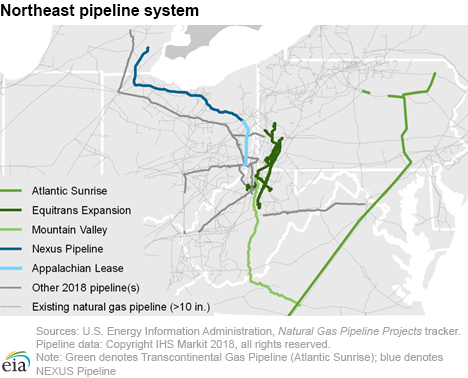
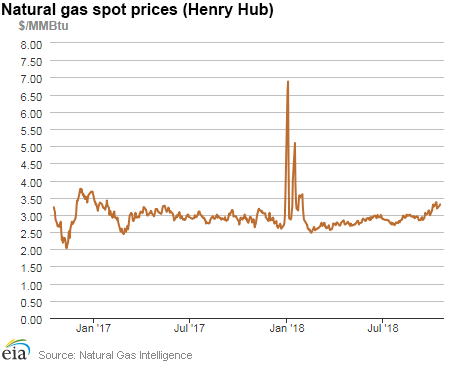
| Spot Prices ($/MMBtu) | Thu, 11-Oct |
Fri, 12-Oct |
Mon, 15-Oct |
Tue, 16-Oct |
Wed, 17-Oct |
|---|---|---|---|---|---|
| Henry Hub |
3.19 |
3.20 |
3.26 |
3.27 |
3.31 |
| New York |
2.79 |
2.76 |
3.18 |
3.11 |
3.40 |
| Chicago |
3.24 |
3.19 |
3.29 |
3.39 |
3.41 |
| Cal. Comp. Avg.* |
3.08 |
3.21 |
3.33 |
3.38 |
3.48 |
| Futures ($/MMBtu) | |||||
| November contract | 3.222 |
3.161 |
3.242 |
3.239 |
3.320 |
| December contract |
3.279 |
3.226 |
3.310 |
3.301 |
3.369 |
| *Avg. of NGI's reported prices for: Malin, PG&E Citygate, and Southern California Border Avg. | |||||
| Sources: Natural Gas Intelligence and CME Group as compiled by Bloomberg, L.P. | |||||
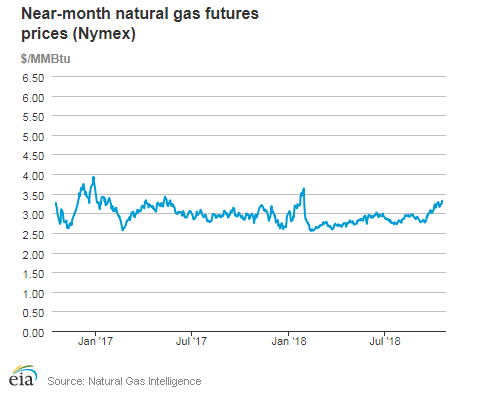
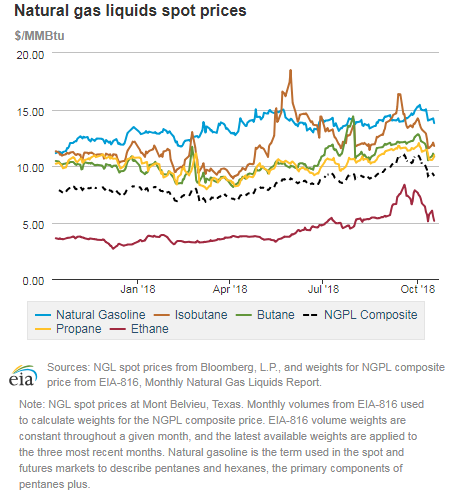
| U.S. natural gas supply - Gas Week: (10/11/18 - 10/17/18) | |||
|---|---|---|---|
Average daily values (Bcf/d): |
|||
this week |
last week |
last year |
|
| Marketed production | 96.1 |
96.2 |
82.3 |
| Dry production | 85.5 |
85.6 |
74.5 |
| Net Canada imports | 4.4 |
5.1 |
5.5 |
| LNG pipeline deliveries | 0.1 |
0.1 |
0.1 |
| Total supply | 90.0 |
90.8 |
80.1 |
|
Source: OPIS PointLogic Energy, an IHS Company | |||
| U.S. natural gas consumption - Gas Week: (10/11/18 - 10/17/18) | |||
|---|---|---|---|
Average daily values (Bcf/d): |
|||
this week |
last week |
last year |
|
| U.S. consumption | 67.8 |
63.7 |
60.7 |
| Power | 25.4 |
31.0 |
26.8 |
| Industrial | 22.1 |
21.0 |
21.5 |
| Residential/commercial | 20.4 |
11.8 |
12.3 |
| Mexico exports | 4.7 |
4.9 |
4.3 |
| Pipeline fuel use/losses | 7.4 |
7.0 |
6.7 |
| LNG pipeline receipts | 3.2 |
2.7 |
2.9 |
| Total demand | 83.1 |
78.3 |
74.6 |
|
Source: OPIS PointLogic Energy, an IHS Company | |||
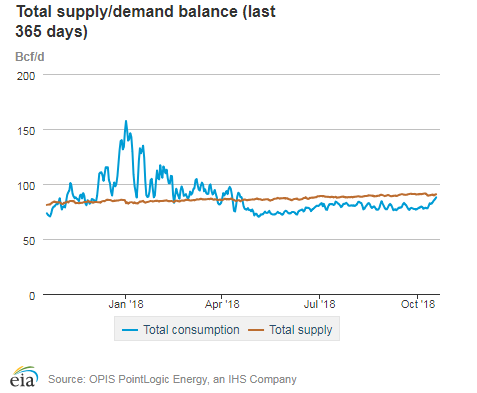
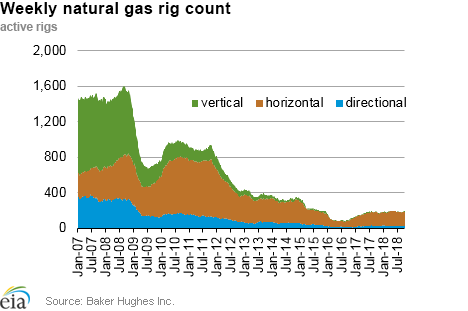
| Rigs | |||
|---|---|---|---|
Tue, October 09, 2018 |
Change from |
||
last week |
last year |
||
| Oil rigs | 869 |
0.9% |
17.0% |
| Natural gas rigs | 193 |
2.1% |
4.3% |
| Note: Excludes any miscellaneous rigs | |||
| Rig numbers by type | |||
|---|---|---|---|
Tue, October 09, 2018 |
Change from |
||
last week |
last year |
||
| Vertical | 66 |
-1.5% |
4.8% |
| Horizontal | 927 |
0.9% |
17.9% |
| Directional | 70 |
6.1% |
-11.4% |
| Source: Baker Hughes Inc. | |||
| Working gas in underground storage | ||||
|---|---|---|---|---|
Stocks billion cubic feet (Bcf) |
||||
| Region | 2018-10-12 |
2018-10-05 |
change |
|
| East | 812 |
790 |
22 |
|
| Midwest | 908 |
871 |
37 |
|
| Mountain | 177 |
180 |
-3 |
|
| Pacific | 264 |
262 |
2 |
|
| South Central | 877 |
854 |
23 |
|
| Total | 3,037 |
2,956 |
81 |
|
| Source: Form EIA-912, "Weekly Underground Natural Gas Storage Report" | ||||
| Working gas in underground storage | |||||
|---|---|---|---|---|---|
Historical comparisons |
|||||
Year ago (10/12/17) |
5-year average (2013-2017) |
||||
| Region | Stocks (Bcf) |
% change |
Stocks (Bcf) |
% change |
|
| East | 899 |
-9.7 |
887 |
-8.5 |
|
| Midwest | 1,050 |
-13.5 |
1,032 |
-12.0 |
|
| Mountain | 224 |
-21.0 |
213 |
-16.9 |
|
| Pacific | 316 |
-16.5 |
344 |
-23.3 |
|
| South Central | 1,150 |
-23.7 |
1,166 |
-24.8 |
|
| Total | 3,638 |
-16.5 |
3,642 |
-16.6 |
|
| Source: Form EIA-912, "Weekly Underground Natural Gas Storage Report" | |||||
| Temperature – heating & cooling degree days (week ending Oct 11) | ||||||||
|---|---|---|---|---|---|---|---|---|
HDD deviation from: |
CDD deviation from: |
|||||||
| Region | HDD Current |
normal |
last year |
CDD Current |
normal |
last year |
||
| New England | 28 |
-56 |
17 |
11 |
11 |
-3 |
||
| Middle Atlantic | 9 |
-63 |
5 |
26 |
24 |
-1 |
||
| E N Central | 29 |
-46 |
2 |
27 |
24 |
16 |
||
| W N Central | 97 |
25 |
32 |
7 |
3 |
-1 |
||
| South Atlantic | 0 |
-36 |
-1 |
85 |
51 |
8 |
||
| E S Central | 2 |
-33 |
0 |
74 |
56 |
19 |
||
| W S Central | 5 |
-5 |
-2 |
73 |
33 |
6 |
||
| Mountain | 109 |
36 |
25 |
6 |
-12 |
-10 |
||
| Pacific | 27 |
2 |
12 |
0 |
-13 |
-10 |
||
| United States | 31 |
-22 |
8 |
38 |
22 |
3 |
||
|
Note: HDD = heating degree day; CDD = cooling degree day Source: National Oceanic and Atmospheric Administration | ||||||||
Average temperature (°F)
7-Day Mean ending Oct 11, 2018
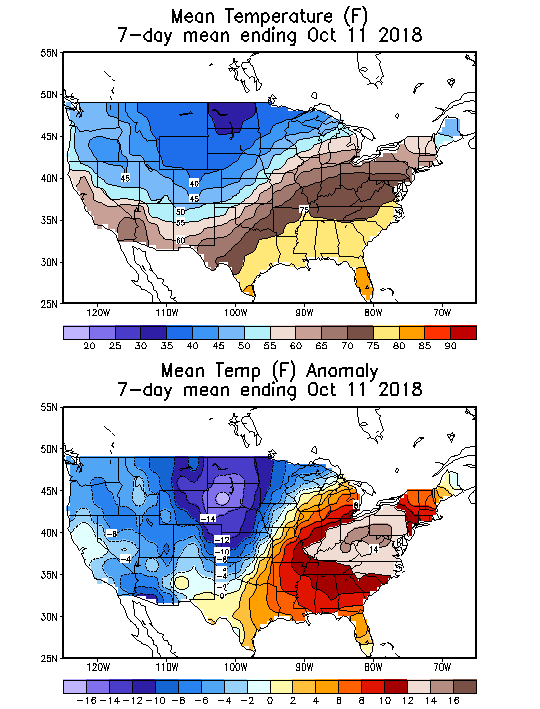
Source: NOAA National Weather Service
Deviation between average and normal (°F)
7-Day Mean ending Oct 11, 2018

Source: NOAA National Weather Service

